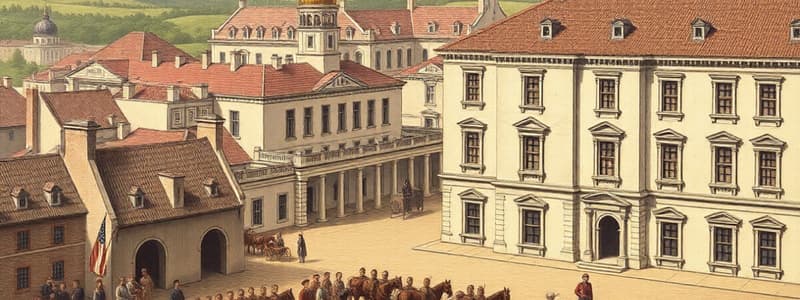Podcast
Questions and Answers
What was the primary role of the governor general in the administrative structure under the Royal government?
What was the primary role of the governor general in the administrative structure under the Royal government?
- Responsible for drafting laws and overseeing court decisions
- Responsible for defense and relations with outside groups/nations (correct)
- Responsible for managing trade and economic policies
- Responsible for civil administration and financial matters
What was the main function of the Sovereign Council in New France's administrative structure?
What was the main function of the Sovereign Council in New France's administrative structure?
- To manage local disputes through seigneurial courts
- To train and drill militia units
- To oversee the collection of taxes from merchants
- To create minor laws and serve as an appeal court (correct)
What characterized the assemblies convened under the Royal government?
What characterized the assemblies convened under the Royal government?
- They were advisory bodies with no obligation on authorities to act (correct)
- They had the power to legislate on behalf of the governor
- They represented the interests of the clergy only
- They were fully democratic institutions with binding authority
How many levels of court were established in New France, from least to most authoritative?
How many levels of court were established in New France, from least to most authoritative?
What was one of the consequences of crime in New France according to the judicial system?
What was one of the consequences of crime in New France according to the judicial system?
What role did nobles play within the social system of New France?
What role did nobles play within the social system of New France?
What was a characteristic of merchants in New France?
What was a characteristic of merchants in New France?
What distinguishes tradesmen in New France from those in France?
What distinguishes tradesmen in New France from those in France?
What was the situation for day laborers in New France?
What was the situation for day laborers in New France?
What legal privilege did clergy enjoy in New France?
What legal privilege did clergy enjoy in New France?
What role did indentured servants play in the population growth of New France?
What role did indentured servants play in the population growth of New France?
What was one reason for the negative perception of New France in France?
What was one reason for the negative perception of New France in France?
How did the French government encourage the settlement of military men in New France?
How did the French government encourage the settlement of military men in New France?
What demographic trend was observed in New France by the year 1700?
What demographic trend was observed in New France by the year 1700?
Why did fewer people migrate to New France compared to other colonies?
Why did fewer people migrate to New France compared to other colonies?
How did the policies regarding marriage and childbirth contribute to population growth in New France?
How did the policies regarding marriage and childbirth contribute to population growth in New France?
What was the gender ratio like in New France before the 1660s?
What was the gender ratio like in New France before the 1660s?
What was the impact of the high birth rates and stable living conditions in New France?
What was the impact of the high birth rates and stable living conditions in New France?
Which group was largely excluded from settling in New France?
Which group was largely excluded from settling in New France?
What consequence did the relatively small population of New France have for its military value?
What consequence did the relatively small population of New France have for its military value?
What impact did the fall of Huronia have on French colonists?
What impact did the fall of Huronia have on French colonists?
What was Bishop Laval's stance on the liquor trade with Indigenous peoples?
What was Bishop Laval's stance on the liquor trade with Indigenous peoples?
What event is Adam Dollard des Ormeaux famous for?
What event is Adam Dollard des Ormeaux famous for?
What led to the Iroquois signing a peace treaty with New France in 1701?
What led to the Iroquois signing a peace treaty with New France in 1701?
What was the primary goal of Jean-Baptiste Colbert for New France?
What was the primary goal of Jean-Baptiste Colbert for New France?
What was a duty of the seigneur under the seigneurial system?
What was a duty of the seigneur under the seigneurial system?
How did the French fur trade evolve after the Huron's decline?
How did the French fur trade evolve after the Huron's decline?
How successful were Jean Talon's initiatives in New France?
How successful were Jean Talon's initiatives in New France?
What strategically significant measure did Louis XIV take regarding New France in 1663?
What strategically significant measure did Louis XIV take regarding New France in 1663?
What was one major challenge the mast industry in New France faced in the 1680s?
What was one major challenge the mast industry in New France faced in the 1680s?
What factor contributed to the animosity between the Iroquois and the Huron?
What factor contributed to the animosity between the Iroquois and the Huron?
What was one consequence of the Iroquois attacks on Huronia in 1649?
What was one consequence of the Iroquois attacks on Huronia in 1649?
Why did many Huron believe Jesuits were responsible for diseases affecting their population?
Why did many Huron believe Jesuits were responsible for diseases affecting their population?
What impact did the economic and military incentives from French officials have on Huron conversion?
What impact did the economic and military incentives from French officials have on Huron conversion?
What was a primary reason for the Huron's inability to defend against Iroquois attacks?
What was a primary reason for the Huron's inability to defend against Iroquois attacks?
What motivated the Iroquois to seek control over Huron territories according to neo-liberal scholars?
What motivated the Iroquois to seek control over Huron territories according to neo-liberal scholars?
Which factor did NOT contribute to the decline of the Huron Confederacy?
Which factor did NOT contribute to the decline of the Huron Confederacy?
Which of the following statements about Jesuit missions among the Huron is true?
Which of the following statements about Jesuit missions among the Huron is true?
What was the aftermath of the Iroquois attacks for the remaining Huron population?
What was the aftermath of the Iroquois attacks for the remaining Huron population?
What was one of the reasons the French did not supply the Huron with more guns?
What was one of the reasons the French did not supply the Huron with more guns?
Flashcards
Governor General
Governor General
The highest ranking official in New France, responsible for defense, relations with other groups and nations.
Intendant
Intendant
The second highest official in New France, responsible for justice, finances, and civil administration.
Sovereign Council
Sovereign Council
The main administrative body in New France, which created minor laws and served as an appeal court.
Captain of Militia
Captain of Militia
Signup and view all the flashcards
Assemblies
Assemblies
Signup and view all the flashcards
Seigneurial Courts
Seigneurial Courts
Signup and view all the flashcards
Royal Courts
Royal Courts
Signup and view all the flashcards
Sovereign Council (Final Appeal Court)
Sovereign Council (Final Appeal Court)
Signup and view all the flashcards
Nobles
Nobles
Signup and view all the flashcards
Clergy
Clergy
Signup and view all the flashcards
The Five Nations League
The Five Nations League
Signup and view all the flashcards
Jesuits and the Huron
Jesuits and the Huron
Signup and view all the flashcards
Huron mistrust of Jesuits
Huron mistrust of Jesuits
Signup and view all the flashcards
Huron factions during Iroquois attacks
Huron factions during Iroquois attacks
Signup and view all the flashcards
The Iroquois Destruction of Huronia
The Iroquois Destruction of Huronia
Signup and view all the flashcards
Huron refugees and scattering
Huron refugees and scattering
Signup and view all the flashcards
Martyrdom of Jesuit missionaries
Martyrdom of Jesuit missionaries
Signup and view all the flashcards
Neo-liberal explanation of Iroquois attacks
Neo-liberal explanation of Iroquois attacks
Signup and view all the flashcards
Relativist explanation of Iroquois attacks
Relativist explanation of Iroquois attacks
Signup and view all the flashcards
Iroquois military superiority
Iroquois military superiority
Signup and view all the flashcards
French Incentives for Immigration
French Incentives for Immigration
Signup and view all the flashcards
French Inheritance Laws and Immigration
French Inheritance Laws and Immigration
Signup and view all the flashcards
Religious Exclusion in New France
Religious Exclusion in New France
Signup and view all the flashcards
New France's Image in France
New France's Image in France
Signup and view all the flashcards
Early Marriage Trends in New France
Early Marriage Trends in New France
Signup and view all the flashcards
Land Abundance and Early Marriage
Land Abundance and Early Marriage
Signup and view all the flashcards
Population Growth Incentives
Population Growth Incentives
Signup and view all the flashcards
Population Comparison: New France vs. English Colonies
Population Comparison: New France vs. English Colonies
Signup and view all the flashcards
Military Vulnerability of New France
Military Vulnerability of New France
Signup and view all the flashcards
Population Growth in New France
Population Growth in New France
Signup and view all the flashcards
How did the fall of the Huron benefit the French fur trade?
How did the fall of the Huron benefit the French fur trade?
Signup and view all the flashcards
What was Bishop Laval's stance on the liquor trade with Indigenous peoples?
What was Bishop Laval's stance on the liquor trade with Indigenous peoples?
Signup and view all the flashcards
What was the significance of Marguerite Bourgeoys' school in Montreal?
What was the significance of Marguerite Bourgeoys' school in Montreal?
Signup and view all the flashcards
Why did the Iroquois attack St. Lawrence settlements?
Why did the Iroquois attack St. Lawrence settlements?
Signup and view all the flashcards
Who was Adam Dollard des Ormeaux, and what was his role in the conflict?
Who was Adam Dollard des Ormeaux, and what was his role in the conflict?
Signup and view all the flashcards
How did France respond to the Iroquois attacks on New France?
How did France respond to the Iroquois attacks on New France?
Signup and view all the flashcards
How did Louis XIV view New France within the context of mercantilism?
How did Louis XIV view New France within the context of mercantilism?
Signup and view all the flashcards
Describe Jean-Baptiste Colbert's 'triangular trade' plan for New France.
Describe Jean-Baptiste Colbert's 'triangular trade' plan for New France.
Signup and view all the flashcards
Explain the seigneurial system in New France.
Explain the seigneurial system in New France.
Signup and view all the flashcards
What were the obligations of seigneurs and censitaires under the seigneurial system?
What were the obligations of seigneurs and censitaires under the seigneurial system?
Signup and view all the flashcards
Study Notes
Administrative Structure (1663-)
- Governor General: Top official, responsible for defense and relations with external groups.
- Intendant: Second-in-command, handled justice, finances, civil administration, policing, defense construction, and soldier provisions/pay.
- Sovereign Council: Main administrative body, created minor laws and acted as an appeals court. Composed of the bishop, attorney general, colonial executives, governor general, and intendant. Mostly judicial, legislative functions delegated to the intendant.
- Captain of Militia: Led and drilled militia units, sometimes carrying out intendant's orders. Unpaid, yet prestigious position.
- Assemblies: Bodies occasionally called for public input, representing a limited form of consultation, but authorities were not obliged to listen. This system was not democratic, only providing some limited avenues for public input.
- Judicial System: Three tiers: seigneurial courts, royal courts, and the Sovereign Council (final appeals court). Decisions from lower courts could be appealed. Torture was used for serious crimes and punishments for convictions were severe (fines, flogging, hanging).. Crime rates in New France were low.
Social System
- Nobles: Held key government and military positions and most seigneurial grants. Involved in trade to a lesser extent. Income from grants was often insufficient for a living standard; primarily sought prestige, hoped for increased land income in the future, and some engaged in trade. Often became dependent on government assistance, aristocratic daughters became nuns.
- Clergy: Enjoyed legal privileges, including exemption from military service.
- Merchants: Cultivated good relations with the government to secure contracts. Generally hard-working, frugal, and invested in businesses. Provisioning the king's troops was a means for financial gain. Not many merchants amassed great wealth.
- Tradesmen: Small-scale contractors (e.g., stonemasons, tanners, tavern keepers, metal workers, wig makers). Unlike France, trades were not heavily regulated in New France, practically anyone could offer services. Surgeons required licenses.
- Day Laborers: Engaged in unskilled, often seasonal work (e.g., carpentry, unloading ships). Struggled to make ends meet, often relying on charity due to seasonal nature of employment.
- Regular Soldiers: Possessed few rights and received very low pay. Came from France, and had less rights than day laborers. Could potentially earn money by working for individuals, but had little personal autonomy and promotion prospects were limited. Primarily lower class.
- Slaves: Predominately of African heritage, and many Native captives. Brought in, worked as domestic servants for the elite.
Indigenous Relations and Conflicts
- Iroquois Confederacy: Formed before European contact, between 1475 and 1525. Huron's refusal to join fueled Iroquois hatred; fur trade rivalry exacerbated tensions.
- Jesuits and Huron: French demanded Huron allow Jesuits into their villages; some Hurons viewed Jesuits as evil shamans, and disease attributed to them.
- Huronia Destruction (1649): Iroquois attacked and eliminated Huronia; missionaries Jean de Brebeuf and Gabriel Lalement were tortured to death. Hurons fled; many died of starvation or were absorbed into Iroquois tribes.
- Reasons for Iroquois attacks on Huronia:
- Historical animosity between the Huron and Iroquois Confederacies.
- Economic motives (neo-liberal arguments) to access or control fur trade.
- Striving for tribal security (relativist arguments) and desire for territorial buffer zones.
- Iroquois Success: Disparity in weaponry (Iroquois had significantly more firearms). French policy favored Huron converts, resulting in their under-armament. Failure of French officials to anticipate the Iroquois’ strength.
- Consequences of Huron Fall: Provided new agricultural markets for French settlers, stimulated farming, and opened inland fur trade routes for Europeans.
- Bishop Laval: Unsuccessfully opposed the liquor trade with Indigenous peoples; opposed by governors.
- Marguerite Bourgeoys: Established schools in Montreal, founding the Congregation de Notre Dame. Reduced illiteracy in the colony.
- New France Besieged (1650-1653, 1658): Iroquois attacks on settlements; peace treaty in 1653, renewed hostilities in 1658.
- Adam Dollard des Ormeaux: Led a small group in an ambush against Iroquois; considered a hero, but may have also been motivated by a desire to steal Iroquois furs instead.
- French Response: French troops committed to protecting New France. 1666 offensive against Mohawk; 1667 treaty, enduring tensions with Iroquois. Resumed hostilities in 1684, culminating in reprisals and war against Seneca Iroquois. Iroquois, with support from New York, attacked Lachine in 1689, resulting in settler deaths and captivity.
- Madeleine de Verchères: Defended her family farm from Iroquois attack, symbol of colonial resilience
New France's Economic Development (1663-)
- Royal Province (1663): Louis XIV designates New France a royal province, aiming to integrate it into France's mercantile economy. Colonial raw materials and captive markets to boost France's economy.
- Colbert's Plan: Minister of colonies, Jean-Baptiste Colbert, established a triangular trade model (France, New France, West Indies). Focused on creating a self-sufficient "compact colony" centered along the St Lawrence River.
- Colonist Initiatives: Attempts to develop the timber industry, mining, beer/footwear manufacture, and shipping fish/agricultural products – mostly unsuccessful. Colonial resource limitations and market distances. Challenges in transporting goods and issues with resource suitability for ship building, preventing colony's economic expansion.
- Seigneurial System: King owned land, grants given to seigneurs who then granted land to censitaires (tenants). 1663, reduced land grants and returned uncultivated land to the Crown to encourage production. Seigneurs’ obligations included land grants to farmer applicants, and building grain mills. Rents and other payments were exchanged.
- Population Growth: Encouragingly, French tried to increase population by sending engages (indentured servants), military men, and filles du roi (young women) to increase the population of New France; This significantly contributed to population growth. However, few Europeans moved to New France due to availability of land and inheritance rights in Europe, a negative perception of New France as well as religious limitations. Despite this, marriages were younger than in France and birth rates were unusually high. This demographic success increased the population from 3,000 in 1663 to 70,000 a century later.
Studying That Suits You
Use AI to generate personalized quizzes and flashcards to suit your learning preferences.




